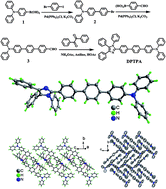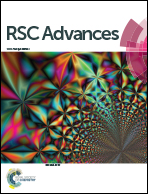Highly-efficient hybrid white organic light-emitting diodes based on a high radiative exciton ratio deep-blue emitter with improved concentration of phosphorescent dopant†
Abstract
An improved concentration of phosphorescent dopant for highly-efficient hybrid white organic light-emitting diodes based on a high radiative exciton ratio (80%) deep-blue emitter has been developed. The high radiative exciton ratio for the deep-blue emitter was found to be the transfer from the higher triplet (T5) to the lowest singlet state (S1) by a “hot-exciton” process. Notably, when the concentration of Ir(2-phq)3 is up to 0.9 wt%, the OLED still exhibited white emission with a maximum total EQE, CE and PE of 22.3%, 53.7 cd A−1 and 60.2 lm W−1, respectively. The exciton transfer mechanism in a high concentration of phosphorescent dopant was also discussed. The studies provide a way to obtain high performance F/P hybrid WOLEDs with a simple architecture and improved doping concentration.


 Please wait while we load your content...
Please wait while we load your content...